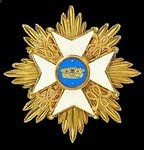First raised 1622 for the Count van Nassau-Dietz. One battalion strong. Province of Geldern
This is my version of the flag of Regiment Ingen-Nielant/Gent/Essen/Plettenberg. Boxel's manual of 1672 merely notes that the flag had blue and white flames, which is all we know, and Bruno Mugnai in his Helion book on the Dutch army 1660-1687 recreates it with a central motif of a bunch of arrows, a common Dutch emblem. For the overall design I used the pattern of flames as shown on the Aylva flag captured at Seneffe 1674 by the French, and on which I am also working. I have chosen an alternative emblem of the armoured arm with a sword for my version. I have been asked for a plausible Colonel's flag so came up with the flag below. Hall shows an example of a Dutch flag claimed to be of this regiment and captured by the French in 1746 at Namur (it is depicted in the Triomphes Louis XV), and suggests it may represent a suitable Colonel's flag. But to my mind Dutch flags changed quite significantly from the WSS to mid-18th century so I am not at all convinced this would be suitable for the WSS or earlier.
This is the page from Boxel's 1672 manual listing flag colours:
Colonels: 1622-1642 Willem Count van Nassau-Dietz; 1642-1661 Eustachius Puchler; 1661-1668 Daniel de Gennis Felin; 1668-1676 Johan Ingen Nielant; 1676-1682 Joachim van Gent, Baron van Meynderswijk; 1682-1699 Philips van Essen van Vanenburg; 1699-1717 Maurits Hendrik van Plettenberg, Herr van Leenhuysen (1702 Brigadier and 1709 General-major)
Service history:
1702: Posted to Sluis
1702-1703: Winter quarters in Flanders
1703: Battle of Stekene
1703-1704: Winter quarters in Flanders
1705: March-April Garrison of Hulst
1710: Siege of Douai
And this was probably the uniform in the late 17th century and also much of the WSS:






















